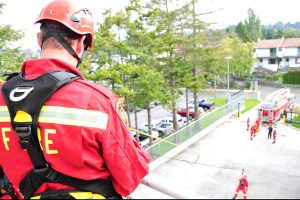Firefighters train in rescue techniques
By Lookout on Oct 14, 2014 with Comments 0

Firefighter Mark Walker takes in the sights during a high line exercise at the CFB Esquimalt Fire Department, Oct. 8.
The training tower of the recently constructed fire hall served as a platform for a unique training session last week.
Firefighters from the CFB Esquimalt Fire Department took part in Confined Space and Rope Rescue certification course taught by Roco Rescue Canada. It included a high line rescue of a mock victim.
During a high line rescue, a series of pulleys, lines, and anchors are used to create a line across a space. A crew can then haul a rescue technician across and over an obstacle to the victim. During a shipboard emergency, the high line can be used to haul a rescue technician over open water.
“That way you can take someone who has been injured, and instead of going across gangways and up and down ladders you can get them straight to the jetty,” says Keith Shields of Roco Rescue, who helped take the firefighters through the course.
Given the unique environment firefighters operate in, Shields says it’s important they be prepared for a variety of situations.
“Working in maritime and military environments presents some unique challenges,” he says. “With these different techniques, they have the tools needed to respond to them.”
The course culminated in a day-long written and practical exam, where firefighters were quizzed on proper operation, terminology, and theory, while also performing practical drills using the techniques learned in training.
“It’s a timed exam, and they’re being held to a national standard, so it can be pretty tough,” says Shields.
When it comes to the course itself, firefighter Lieutenant Keith Lee says the course goes a long way towards bridging the gap in experience.
“Some of this is new knowledge for a lot of us, but it’s the right training to have,” he says. “It’s our responsibility as a department to be prepared for confined space rescues and line work. It’s great to have Roco come and train us, especially with our own gear, so we know exactly what to expect should we have to use the skills in the field.”
After the course, successful graduates are certified to bring these techniques back to their individual crews for training; something Lee says will bring up the skill level and confidence of the entire department.
“It’s about maintaining a national standard – the standard of the National Fire Protection Association,” says Shields. “When you train to the same standard as every other agency in the country, when you work together, as CFB Esquimalt Fire Department often does, you speak the same language.”
Shawn O’Hara, Staff Writer
Filed Under: Top Stories
About the Author:





